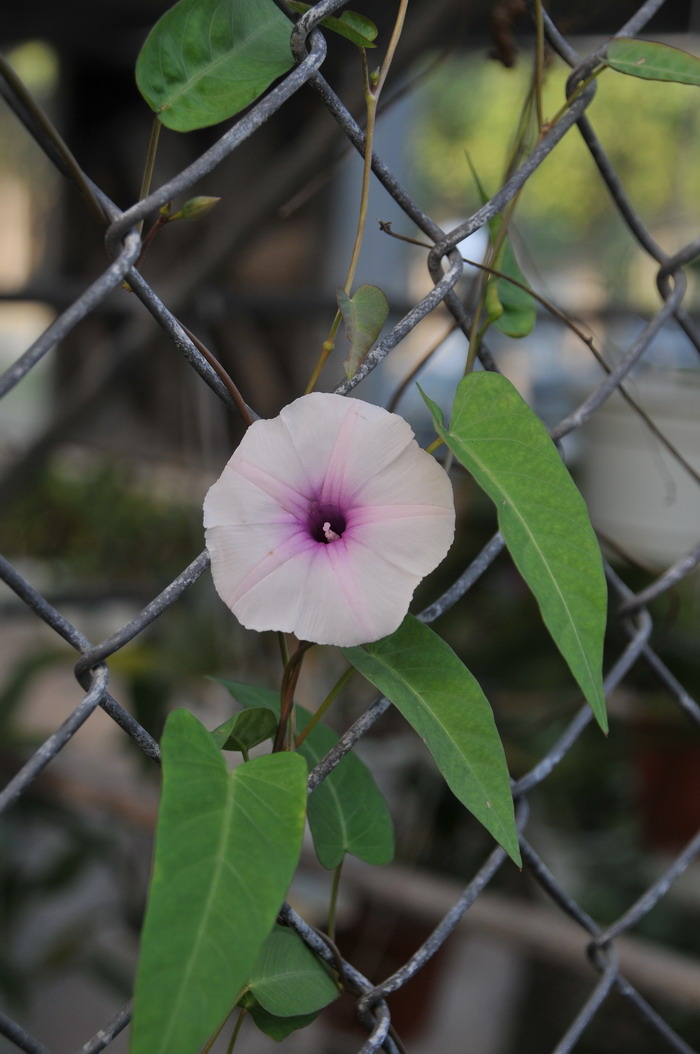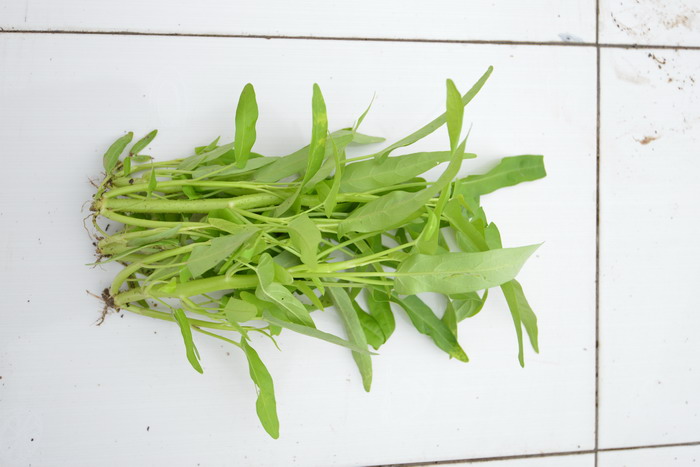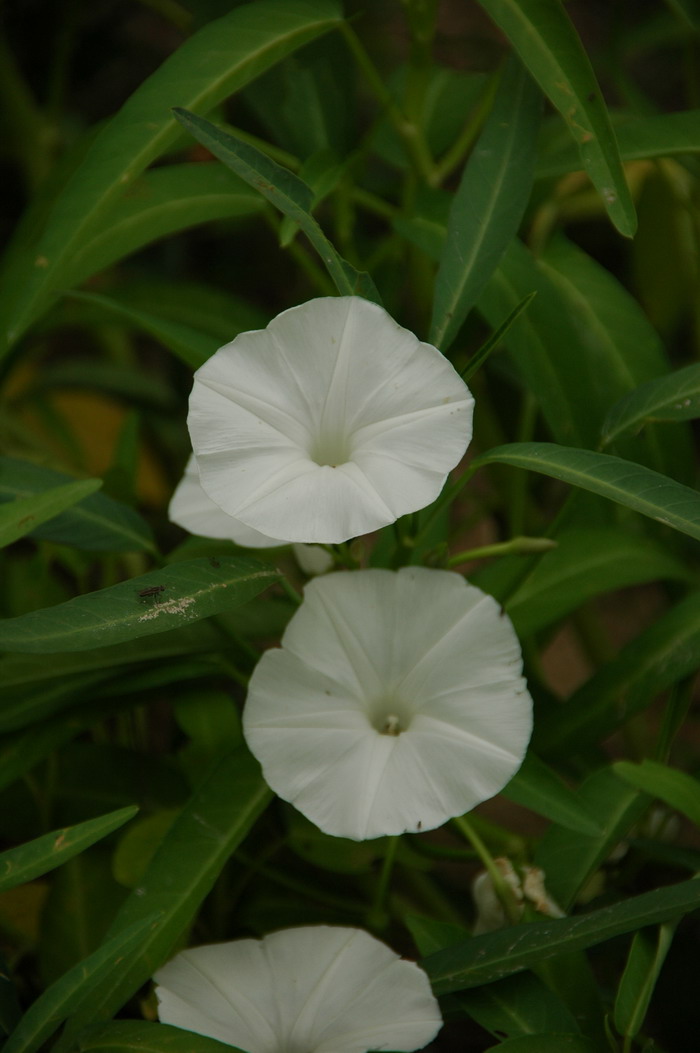通心菜Ipomoea aquatica
中文名(Chinese Name):通心菜
学名(Scientific Name):Ipomoea aquatica Forssk.
英文名(English Common Name):swamp morning-glory
别名(Chinese Common Name):蕹菜、空心菜
异名(Synonym):Convolvulus repens Vahl Ipomoea reptans Poir. Ipomoea subdentata Miq. Ipomoea natans Dinter & Suess. Ipomoea sagittaefolia Hochr.
科属(Family & Genus):旋花科(Convolvulaceae)番薯属
形态特征(Description):一年生草本,蔓生或漂浮于水。茎圆柱形,有节,节间中空,节上生根,无毛。叶片形 状、大小有变化,卵形、长卵形、长卵状披针形或披针形,长3.5-17厘米,宽0.9-8.5厘米,顶端锐尖或渐尖,具小短尖头,基部心形、戟形或箭形,偶尔截形,全缘或波状,或有时基部有少数粗齿,两面近无毛或偶有稀疏柔毛;叶柄长3-14厘米,无毛。聚伞花序腋生花序梗长1.5-9厘米,基部被柔毛,向上无毛,具1-3(-5)朵花;苞片小鳞片状,长1.5-2毫米;花梗长1.5-5厘米,无毛;萼片近于等长,卵形,长7-8毫米,顶端钝,具小短尖头,外面无毛;花冠白色、淡红色或紫红色,漏斗状,长3.5-5厘米;雄蕊不等长,花丝基部被毛;子房圆锥状,无毛。蒴果卵球形至球形,径约1厘米,无毛。种子密被短柔毛或有时无毛。
分布(Distribution):原产我国,现广为栽培。现遍及热带亚洲、非洲及大洋洲。
用途(Use):供蔬菜食用外,尚可药用。
引自中国植物志英文版FOC Vol. 16 Page 307
Ipomoea aquatica Forsskål, Fl. Aegypt.-Arab. 44. 1775.
蕹菜 weng cai | Convolvulaceae | Ipomoea
Convolvulus repens Vahl; Ipomoea repens Roth; I. reptans Poiret; I. subdentata Miquel.
Herbs annual, terrestrial and repent or floating; axial parts glabrous. Stems terete, thick, hollow, rooting at nodes. Petiole 3-14 cm, glabrous; leaf blade variable, ovate, ovate-lanceolate, oblong, or lanceolate, 3.5-17 X 0.9-8.5 cm, glabrous or rarely pilose, base cordate, sagittate or hastate, occasionally truncate, margin entire or undulate, apex acute or acuminate. Inflorescences 1-3(-5)-flowered; peduncle 1.5-9 cm, base pubescent; bracts squamiform, 1.5-2 mm. Pedicel 1.5-5 cm. Sepals subequal, glabrous; outer 2 ovate-oblong, 7-8 mm, margin whitish, thin, apex obtuse, mucronulate; inner 3 ovate-elliptic, ca. 8 mm. Corolla white, pink, or lilac, with a darker center, funnelform, 3.5-5 cm, glabrous. Stamens unequal, included. Pistil included; ovary conical, glabrous. Stigma 2-lobed. Capsule ovoid to globose, ca. 1 cm in diam., woody, tardily dehiscent or ?indehiscent. Seeds densely grayish pubescent, sometimes glabrous. 2n = 30*.
Marshy habitats: ditches, ponds, rice paddies, waste areas. C to S China, native and cultivated [Bangladesh, Cambodia, India, Indonesia, Laos, Malaysia, Myanmar, Nepal, New Guinea, Pakistan, Philippines, Sri Lanka, Thailand, Vietnam; Africa, Australia, Pacific Islands, South America]
Commonly cultivated as a pot herb, Ipomoea aquatica is adapted to a warm, moist climate and cannot survive frost. Several races are recognized (without formal taxonomic designation) based on growing conditions (terrestrial vs. aquatic) and plant and flower color (greenish plants with white flowers vs. purplish tinged plants with lilac flowers). The plants have minor medicinal uses and also are used for forage.



(责任编辑:徐晔春)
学名(Scientific Name):Ipomoea aquatica Forssk.
英文名(English Common Name):swamp morning-glory
别名(Chinese Common Name):蕹菜、空心菜
异名(Synonym):Convolvulus repens Vahl Ipomoea reptans Poir. Ipomoea subdentata Miq. Ipomoea natans Dinter & Suess. Ipomoea sagittaefolia Hochr.
科属(Family & Genus):旋花科(Convolvulaceae)番薯属
形态特征(Description):一年生草本,蔓生或漂浮于水。茎圆柱形,有节,节间中空,节上生根,无毛。叶片形 状、大小有变化,卵形、长卵形、长卵状披针形或披针形,长3.5-17厘米,宽0.9-8.5厘米,顶端锐尖或渐尖,具小短尖头,基部心形、戟形或箭形,偶尔截形,全缘或波状,或有时基部有少数粗齿,两面近无毛或偶有稀疏柔毛;叶柄长3-14厘米,无毛。聚伞花序腋生花序梗长1.5-9厘米,基部被柔毛,向上无毛,具1-3(-5)朵花;苞片小鳞片状,长1.5-2毫米;花梗长1.5-5厘米,无毛;萼片近于等长,卵形,长7-8毫米,顶端钝,具小短尖头,外面无毛;花冠白色、淡红色或紫红色,漏斗状,长3.5-5厘米;雄蕊不等长,花丝基部被毛;子房圆锥状,无毛。蒴果卵球形至球形,径约1厘米,无毛。种子密被短柔毛或有时无毛。
分布(Distribution):原产我国,现广为栽培。现遍及热带亚洲、非洲及大洋洲。
用途(Use):供蔬菜食用外,尚可药用。
引自中国植物志英文版FOC Vol. 16 Page 307
Ipomoea aquatica Forsskål, Fl. Aegypt.-Arab. 44. 1775.
蕹菜 weng cai | Convolvulaceae | Ipomoea
Convolvulus repens Vahl; Ipomoea repens Roth; I. reptans Poiret; I. subdentata Miquel.
Herbs annual, terrestrial and repent or floating; axial parts glabrous. Stems terete, thick, hollow, rooting at nodes. Petiole 3-14 cm, glabrous; leaf blade variable, ovate, ovate-lanceolate, oblong, or lanceolate, 3.5-17 X 0.9-8.5 cm, glabrous or rarely pilose, base cordate, sagittate or hastate, occasionally truncate, margin entire or undulate, apex acute or acuminate. Inflorescences 1-3(-5)-flowered; peduncle 1.5-9 cm, base pubescent; bracts squamiform, 1.5-2 mm. Pedicel 1.5-5 cm. Sepals subequal, glabrous; outer 2 ovate-oblong, 7-8 mm, margin whitish, thin, apex obtuse, mucronulate; inner 3 ovate-elliptic, ca. 8 mm. Corolla white, pink, or lilac, with a darker center, funnelform, 3.5-5 cm, glabrous. Stamens unequal, included. Pistil included; ovary conical, glabrous. Stigma 2-lobed. Capsule ovoid to globose, ca. 1 cm in diam., woody, tardily dehiscent or ?indehiscent. Seeds densely grayish pubescent, sometimes glabrous. 2n = 30*.
Marshy habitats: ditches, ponds, rice paddies, waste areas. C to S China, native and cultivated [Bangladesh, Cambodia, India, Indonesia, Laos, Malaysia, Myanmar, Nepal, New Guinea, Pakistan, Philippines, Sri Lanka, Thailand, Vietnam; Africa, Australia, Pacific Islands, South America]
Commonly cultivated as a pot herb, Ipomoea aquatica is adapted to a warm, moist climate and cannot survive frost. Several races are recognized (without formal taxonomic designation) based on growing conditions (terrestrial vs. aquatic) and plant and flower color (greenish plants with white flowers vs. purplish tinged plants with lilac flowers). The plants have minor medicinal uses and also are used for forage.
(责任编辑:徐晔春)
踩一下[0]

顶一下[4]